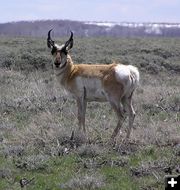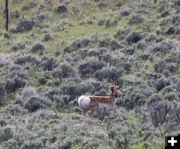Wyoming Antelope
They’re really pronghorn, and they have horns not antlers
February 12, 2006
While not as glamorous as elk, moose and deer, Wyoming’s antelope are getting a lot of attention lately with concerns over possible habitat loss and impacts on herds in our Upper Green River Valley due to the oil and gas activity explosion.
They’re really pronghorn, not antelope
The correct name for these animals is pronghorn, not antelope, and they are not related to antelope. That being said, most people still call them antelope.
How many pronghorn are there in Wyoming?
According to the Spring 2005 Big Game Outlook and Estimated Economic Impact from Sportsmen, a Wyoming Legislative Fact Sheet, there are slightly more humans in the state of Wyoming than pronghorn. Populations have risen steadily over the past six years. In 2004, there were more than 489,900 pronghorn in Wyoming, according to the Wyoming Game & Fish Department. At one time, pronghorn numbered approximately 40 million strong on the North American plains.
Hunting
In 2004, the Wyoming Game & Fish Department sold 44,653 licenses to hunt pronghorn to resident and non-resident hunters in the state. Those hunters had an overall success rate of 96.3%. Between 1995 and 2004, hunters harvested an average of 31,800 pronghorn EACH YEAR in Wyoming. There were 317,981 pronghorn legally harvested by hunters between 1995 and 2004 with archery, muzzle loading and firearm hunts in Wyoming. There were over 1700 pronghorn licenses issued for the Hoback, Gros Ventre, Beaver and Pinedale hunt areas in 2004, with hunters reporting an 81-100% success rate. Pronghorn hunting season is from late September to the end of November each year, with the exact dates varying by specific hunt area.
Pronghorn have horns, not antlers
One of the differences between pronghorn and deer/moose/elk is that they have true horns, rather than antlers. Pronghorn do not drop their horns every year, so you won’t find their horns on the ground this spring if you’ve just picked up the hobby of antler hunting. What you might find is the cone shaped hollow outer horn sheath which is shed each year as the horn grows.
Both male and female pronghorn can have horns, although the female’s horns are much smaller, if they have them at all. Both sexes have white rumps, white throat stripes and white sides. Males also have dark patches on their necks. They weigh from 75-140 pounds and stand about 3-1/2 feet high at the shoulder.
Where do they live?
These herd animals prefer open prairie and sagebrush plains, although they are sometimes seen up in the trees along the forest boundaries adjacent to the open areas. If you are looking to hunt them on public land, you’ll find them more on BLM land than on the National Forest.
Pronghorn are roaming animals with a home range that can cover large areas between winter and summer ranges. They typically congregate on the southern end of our Green River Valley in the winter, where there is less snow. They disperse to the northern portions of the valley and higher elevations in the spring with the grass green-up as the snow melts off.
When alarmed, pronghorn can run at speeds over 50 miles per hour. It is the fastest mammal in the Western Hemisphere and one of the fastest in the world. They are poor jumpers and prefer to crawl through a barb wire fence than jump over it.
What do they eat?
Pronghorn are grazing animals. In the winter, they eat almost exclusively sagebrush and woody shrubs. In the spring and summer, they also feed on weeds and grasses. If agricultural areas are nearby, they may be found in crops of alfalfa or sharing grass pastures with cattle.
Young
Babies are born around July, after a gestation of about 7-1/2 to 8 months. Does may give birth to one fawn or twins. Baby pronghorn are up and walking within minutes of birth.
About that migration corridor
It is interesting to note that of these hundreds of thousands of pronghorn that live throughout Wyoming, approximately 489,700 of these animals DON’T go on what environmental groups are trying to label as "Continental America's longest big game migration route" for pronghorn through the Upper Green River Valley to the Jackson Hole area. Approximately 300 pronghorn, out of a total population of approximately 490,000 animals in Wyoming, find their way past Pinedale each summer to end up in the Jackson Hole area. We’ll let you do the math on what percentage of the total pronghorn population that works out to that use this route as part of their travel patterns.
References:
Wyoming Game & Fish 2004 Antelope Harvest Reports
Mammals of the Rocky Mountains, Lone Pine Field Guide, 2000
Spring 2005 Big Game Outlook and Estimated Economic Impact from Sportsmen
Jackson Hole Pronghorn Study, Hal Sawyer & Fred Lindsey, Sept. 2000
|

